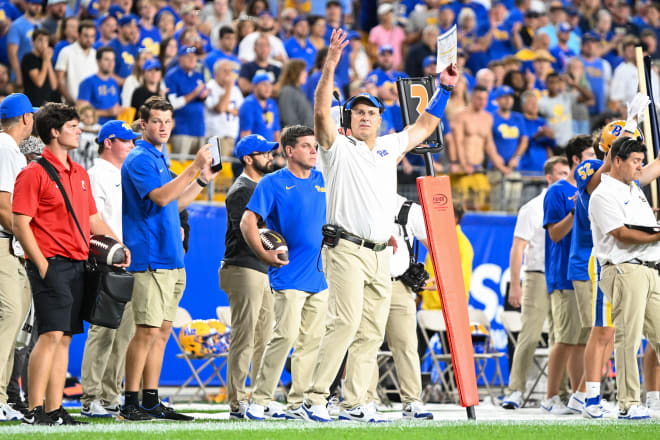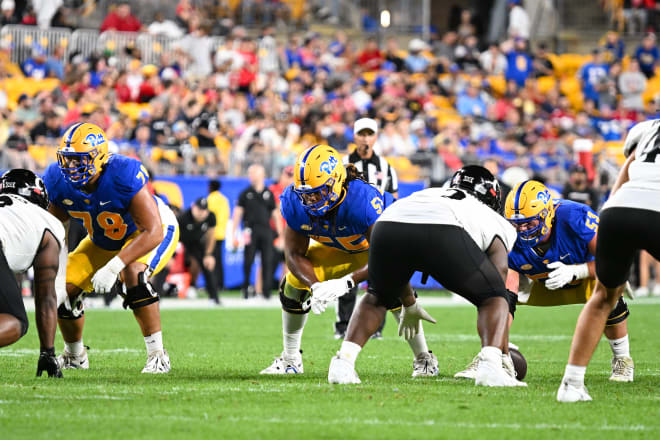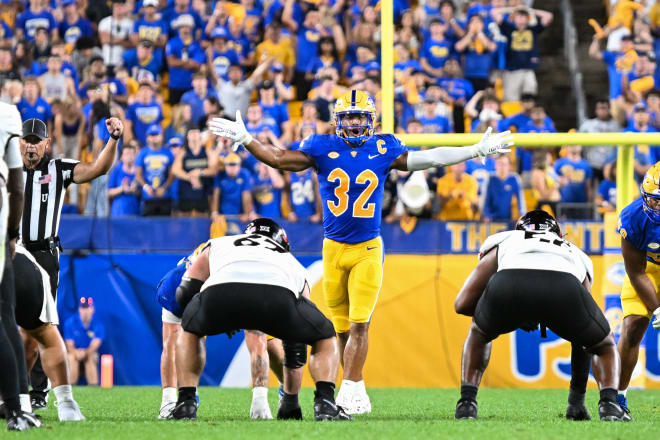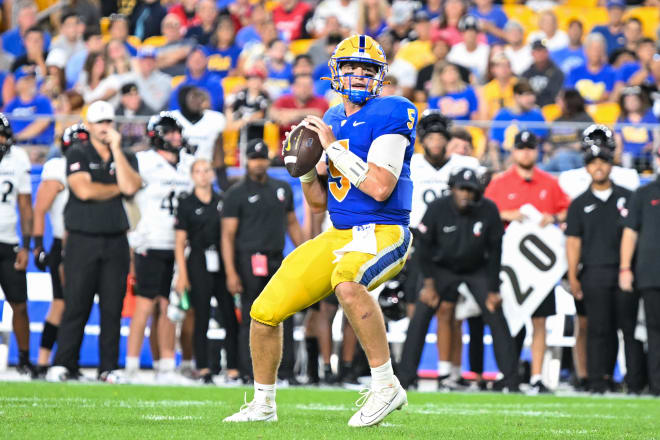The 3-2-1 Column: Offensive improvement, RB questions, Jurkovec and more
In this week's 3-2-1 Column, we're looking at the areas where Pitt has to improve on both sides of the ball, what the running back rotation needs to look like, whether Pitt will change quarterbacks and a lot more.

THREE THINGS WE KNOW
Three things that have to improve
Let’s start with offense, and let’s start by setting aside the obvious.
Phil Jurkovec has to be better. His receivers do, too, and his offensive coordinator. But quarterbacks know what they’re signing up for - all the glory and all the blame - and Jurkovec signed up for it a long time ago. So whether some of those terrible plays on Saturday were his fault or the fault of others is a moot point here. He’s got to do better, and he probably knows it.
Now that we have that out of the way, here are three other things Pitt’s offense needs to improve for this week’s game at West Virginia.
1. The run game
Seriously, was that a Pat Narduzzi/Frank Cignetti team we watched against Cincinnati? 29 total rushing attempts and just 18 for the running backs?
18? Did Narduzzi and Cignetti lose a bet or something? I know Pitt was playing from behind, but the score was never so lopsided that they had to completely abandon the running game, and even before Cincinnati took a 13-point lead at halftime, they gave the ball to the running backs just six times in the first 16 times plays.
Rodney Hammond didn’t get a carry until Pitt’s third drive of the game, and when they finally gave him the ball, he bounced it outside for 11 yards.
Imagine that. Positive yardage from a handoff to Hammond. Probably should try to do that more.
The strangest part is that this team’s offensive identity is built on the run game. Forget all the talk from training camp about being some deep-shot vertical passing team; they might try those passes, but the bread and butter is the passing game, and on Saturday, Pitt had neither the bread nor the butter - by choice, it seemed. That choice has to be reversed this week and beyond, and I think it will be.
2. Play-action
And the run game needs to be activated because it’s the foundation of the play-action passing game, which is a key piece of the puzzle. Except it hasn’t been this season, as Jurkovec has dropped back 65 times and run play-action just nine times, according to Pro Football Focus. That’s 13.8% of the total drop-backs.
Against Cincinnati, Jurkovec dropped back with play-action just three times. Now, he didn’t complete a single one of the passing attempts on those plays, but that’s beside the point.
Pitt is supposed to be a run-based offense with a play-action passing game. But in the first real game of the season, the Panthers didn’t do either one of those things, and while there are a lot of reasons the offense struggled against the Bearcats, completely deviating from the identity seems like a pretty big one.
3. Wide receiver priorities
Hello, this is your captain speaking. We here on the Bub Means Hype Train regret to inform you that we may need to decrease speed here for a bit.
If nothing else, we might at least need to decrease the depth, because Means has been getting thrown the ball too far down the field through two games this season.
Like, way too far. As in, an average depth of target of 23.3 yards per target; that’s the second-highest ADOT of any receiver in the country who has seen at least 10 total targets (Virginia Tech’s Da’Quan Felton has the highest ADOT at 25.5 yards on his 10 targets, and he has only caught one pass, so that’s not exactly the kind of company you want to keep).
No player in the country has seen more targets at a depth of 20 yards or greater than Means has. And yet he is not among the 360 players who have caught at least one target at a depth of 20 yards or greater.
Seriously, PFF lists 360 FBS players across all positions who have caught at least one 20-yard pass. And Means isn’t on that list. I don’t mind throwing him deep shots; he’s got a chance to make some of those plays, so they’re worth trying. But maybe don’t try so many, and also maybe try to work him on some shorter throws. He might have a better chance of making plays if you do that. And in the meantime, Konata Mumpfield, Gavin Bartholomew and Daejon Reynolds (combined 16 catches on 25 targets) currently present better options in the passing game.

Three more things that have to improve
Let’s flip to the defense. What needs to get better in Morgantown and beyond?
1. The pass rush
So far this season, Pitt has produced 32 pressures (per Pro Football Focus) and six sacks (per the official box score). For comparison, after facing West Virginia and Tennessee in the first two games last season, the Panthers had recorded 42 pressures (21 against each team) and six sacks.
Same number of sacks but a lot more pressures in 2022 - and against better competition.
Look, I know Calijah Kancey isn’t walking through that door, but Pitt simply has to get more pressure on the quarterback. It’s going to be important against Garrett Greene and WVU this week, and it’s going to be doubly important against Drake Maye and North Carolina next week.
Getting to the quarterback has been a hallmark of Pitt’s defense over the last few seasons; so far, the 2023 defense is not quite living up to its predecessors. That’s somewhat to be expected, given the personnel turnover, but the excuse of productive players leaving and inexperienced players replacing them can only hold for so long; at some point, the pass rush has to make more of an impact.
2. Run defense
I’m a little less concerned about this, but it’s still worth keeping an eye on. Pitt gave up 216 rushing yards to Cincinnati last week, highlighted - or low-lighted, depending on your perspective - by 180 rushing yards in the first half.
That’s bad. Really bad. And unacceptable for a defense that is built, first and foremost, to stop the run. For all the things that went wrong on Saturday, I can’t imagine any of them bothered Pat Narduzzi as much as that one. For Narduzzi, that’s the proverbial “flames about three feet high,” if you take my meaning.
I’m somewhat confident here, though. Pitt’s run defense didn’t exactly start 2022 on a high note either. C.J. Donaldson came out of nowhere and rushed for 125 yards and seven carries and West Virginia put up 190 yards on the ground in the season opener, which would have been 200+ if not for J.T. Daniels losing 20 or so.
It was a very concerning performance from Pitt’s run defense, but in the week that followed, the coaches tightened things up a bit and the result was a much better performance against Tennessee, holding what would become a top-30 rushing offense to less than 100 yards on the ground.
I don’t know if Pitt will engineer that drastic of a turnaround this year, but the precedent does exist, and given that the entire structure of this defense is geared toward stopping the run, I think the coaches will get that figured out.
3. The safety rotation
This is less a thing to improve and more a thing to watch. Last Saturday, Javon McIntyre and P.J. O’Brien started at safety, just as they had in the opener against Wofford. They played most of the first half, with occasional substitutions, and into the second half before, on the third series, Donovan McMillon took over for O’Brien and stayed in the game until the end.
That was a notable change, since O’Brien has been in the program for a few years and was the apparent next-in-line at field safety after the departure of Erick Hallett.
But McMillon, a former four-star prospect from Peters Township, came in as a hyped transfer from Florida this offseason, and if the adjusted rotation we saw on Saturday was any indication, he might have passed O’Brien for a spot in the top two.
I’ve said since the summer that we’ll likely see more rotation at safety than we have in the past, and I imagine that will continue. Put another way, I think we’ll see a lot of McIntyre, McMillon, O’Brien and Stephon Hall.
If McMillon steps into a starting job, though, that will be very interesting. I imagine the coaches are still figuring out the best pairing(s) to go with, and this week will be another testing ground along those lines.

The Brawl will have energy
Something weird is happening this week, and I know I’m not the first - or only - one to notice.
We’re approaching the 24-hour march to the 106th Backyard Brawl and, well, the buzz is not exactly taking over the city.
There’s probably a lot of reasons for that. Neither fan base really knows how good their team is. Pitt is coming off a loss, of course, and West Virginia is coming off a win over Duquesne that was preceded by a loss at Penn State.
Two 1-1 teams with an FCS win as the only positive on the resume and some big questions casting dark shadows…that’s not exactly getting people fired up, and I understand it.
WVU fans have serious concerns about the state of the coaching staff and whether head coach Neal Brown should or will keep his job. Pitt fans have serious concerns about the state of the offense and whether the Panthers will be able to score enough to continue the success of winning 20 games over the last two years.
Neither fanbase is in a great spot emotionally right now, and that has taken some of the luster off the Brawl, aside from some social media spats that aren’t really all that interesting (and even those have felt somewhat manufactured).
But I’m pretty confident about one thing:
The minute these two teams step onto the field, it’s going to be awesome. The hype will return and the energy will bubble over. Eventually, it’s going to be bad for one of these sides, but when the game starts, you’re going to feel it. Everybody is going to feel it.
And I can’t wait. The Brawl is pretty much guaranteed to be a great environment. It was last year at Acrisure Stadium, just like it was 12 years ago the last time Pitt faced WVU in Morgantown. The WVU fans will be fired up and rowdy and the traveling Pitt contingent will do its best to match the energy, if not the numbers. And when one of these teams takes control of the game, boy howdy look out, because the fans are going to make sure everybody knows it.
Of course, one of those fanbases is going to leave the game with heavy hearts, and that will only be made worse by the other fanbase for the next, oh, 363 days or so until WVU comes to Acrisure Stadium next September.
In the meantime, when these two teams step onto the field at Milan-Puskar, the energy is going to get turned up in that special way that only seems to really happen at college football games. Sure, there’s energy in NFL games; Monday night’s local event will have quite a bit of energy, no doubt.
But there’s something different about college games. Maybe it’s the direct tie: most people who are Pitt fans went to Pitt, and pretty much all West Virginia fans are from West Virginia, which counts since it’s basically the No. 1 sports team for the entire state.
College football fans are invested in a way that pretty much no other sport can touch, and they have a dedication and devotion that every other sport dreams of.
Pitt and WVU fans have been distracted by their own woes this week, but when this game kicks off Saturday night, we’re all going to remember why the Brawl is held in such high regard.
Can’t wait.

TWO QUESTIONS WE HAVE
Who’s it on?
This is a question as old as time, one that has been asked since before the dawn of civilization, when one ape picked up a rock and threw it to another ape, but the second ape didn’t realize a third ape was playing off coverage and should have cut off his route for a comeback so the first ape’s throw looked woefully off-target and a bunch of other apes watching from a treetop grunted and shrieked at the first ape, incredulous that he could make such a bad throw but unaware that the second ape misplayed the coverage.
Man, the connections to our evolutionary ancestors are uncanny, aren’t they?
Like those apes in the treetops, Acrisure Stadium was full of grunts and shrieks on Saturday, all calling for the head of Pitt’s quarterback who did, to be fair, mostly deserve it as his passes fell above, beyond and behind their intended targets.
But was it all his fault?
Chances are, we’ll never really know. There are people who do know, of course, but they’re in Pitt’s building in the South Side. They have playbooks and film sessions, and they know what was supposed to happen on some of Jurkovec’s more egregious misfires in the passing game.
They know whether Jurkovec missed horribly or if Means - or the other receivers, but mostly Means - misread coverage or simply blew the whole play.
It was one or the other, and maybe sometimes both, but we’ll never really know who to truly blame.
We know what we saw, though. We saw a quarterback who’s not known for his accuracy sail passes past the receivers, so it’s on him. That’s what we saw, so we’re going after the quarterback.
As we’ve had this conversation this week and discussed the Will He Or Won’t He as it relates to Pat Narduzzi benching a quarterback (he will, just maybe not right now, as we’ll discuss), I was reminded of a discussion topic from a year ago.
It was probably in October, when Pitt was mired in a losing streak and the season seemed to be slipping away as the offense sputtered. I wrote and talked about the question of blame, and I framed it as a major question Narduzzi needed to answer.
In that instance, the question was whether more blame for the offensive woes should fall on the quarterback or the offensive coordinator? It had to be one or the other - even if it was a little bit of both - and wherever Narduzzi landed on that question would determine his next step.
I can’t say for certain that he decided the quarterback was the bigger issue, but the coordinator’s still here and the quarterback isn’t, so that might be some insight on what he concluded (although it’s probably more complicated than that).
Either way, we’re back to the blame game, which is to be expected after a performance like we saw on Saturday.
But whether the blame falls on Jurkovec or Means or Cignetti or some other party we haven’t considered, it’s up to the coaches to find the right answer.
Narduzzi said on Monday that the first game - or, in this instance, the first “real” game - goes a long way in illustrating to the coaching staff just where exactly the problems are. It identifies the problems and lays them bare for all to see.
Well, we saw them. Now the staff has to fix them, wherever the blame belongs.

How will the running back rotation shake out?
I mentioned the running game earlier, but I want to come back to it here. As I sifted through my notes from the Cincinnati game, I pieced together what I believe was the intention with the running back rotation.
As far as I can tell, the basic idea was this: alternating series for Rodney Hammond and C’Bo Flemister with Daniel Carter as the third-down back.
There were exceptions, but that’s more or less the script they followed in that game (or, if it wasn’t exactly scripted that way, that’s how it worked out). Hammond took the first and third possessions in the first half and Flemister took the second and fourth, and Hammond took the first, third and fifth drives in the second half and Flemister took the fourth and sixth - the second drive in the second half was kind of a mishmash, with Flemister starting it and playing four of the 10 snaps, Hammond taking two snaps and Carter playing four.
I don’t want to get bogged down in the details, though, or the fact that Carter was the third-down back except for one third-and-12 in the first half and a pair of third downs in the second half. Sometimes things change on the fly, but for the most part, it was Hammond alternating with Flemister and Carter as the third-down back. That was the plan.
And I wonder if it was really the best approach.
I still believe Hammond is the best back on the team (Montravius Lloyd might disagree, but the coaches need to figure out what to do with their junior and senior backs before worrying about the freshman). And if Hammond is, in fact, the best back on the team, then he needs to get more than every other series.
I said before the season that I thought the running backs would be a bit more evenly split in carries than what we saw last year, when Israel Abanikanda got more than 60% of the attempts in the games he played, and that has been the case so far: Pitt’s running backs have recorded 50 rushing attempts through two games this season, with Carter getting 17 (34%), Flemister getting 15 (30%) and Hammond taking 11 (22%).
But even though I predicted a more even distribution of carries - and I’m never one to walk away from a correct prediction - I think wildly low for Hammond. He may not get 60% of the carries, but he needs more than 11%. He needs more than 35%, for that matter.
To me, Hammond should be getting close to or north of 50% of the attempts, and he needs to be on the field in order to get those carries. Hammond and Carter each played 23 offensive snaps against Cincinnati and Flemister played 21, according to Pro Football Focus. That’s just not a good distribution, if you ask me. I would probably go two series of Hammond and one of Flemister and alternate that way until it feels appropriate to either go with Hammond every drive (because the game is close) or Flemister and Carter every drive (because the game is not close).
The coaches know the personnel, of course, but I can’t imagine they really want to use this every-other-drive system again.

ONE PREDICTION
Pitt won’t change quarterbacks
Let’s beat this particular dead horse one more time this week.
I really think it’s not happening.
I know Phil Jurkovec completed 10-of-32 passes against Cincinnati on Saturday. I know that’s arguably the worst performance by a Pitt quarterback since at least the 2018 ACC Championship Game and maybe longer.
Fun fact: Nathan Peterman twice completed less than 10 passes as Pitt’s starting quarterback, and the Panthers won both of those games (Virginia Tech 2015 and Syracuse 2016). Chad Voytik actually did it four times in Pitt wins. Wild stuff.
But let’s get back to the present. Phil Jurkovec is the present, and he’s probably the future, too. If there’s anything I’ve taken away from this week - from Pitt’s coaches, players and just about anyone else around the program - it’s two things:
1. Jurkovec is better than he showed against Cincinnati.
2. The problems weren’t all on him.
On the second point, there were clearly issues all over the place. The pass protection was a big one; Pro Football Focus said Jurkovec was under pressure on 47.5% of his drop-backs. That’s a pretty tough way to make a living, and he completed 3-of-11 passes (27.3%) in those situations, although that did include one of his touchdown throws.
Pitt’s receivers - Bub Means, in particular - also didn’t do a ton to help Jurkovec, and that has to be considered.
Also to be considered is that Jurkovec made some good throws. The touchdown passes to Konata Mumpfield and Gavin Bartholomew were good, if not great, and he had a couple other throws to the end zone - Means and Karter Johnson come to mind - where the intended target didn’t seem to have a sense of what kind of throw was coming and didn’t make a play.
For whatever it’s worth, PFF credited Jurkovec with five “big-time throws” in the game, which the site defines as “a pass with excellent ball location and timing, generally thrown further down the field and/or into a tighter window.” So take that how you will, but also take this:
PFF charged Jurkovec with only one “turnover worthy play,” defined as “a pass that has a high percentage chance to be intercepted or a poor job of taking care of the ball and fumbling.” Jurkovec fumbled, as we know, so that would seem to indicate that PFF didn’t see any of his throws as putting the ball in jeopardy.
And I think that’s an important point we have to keep in mind when considering the long-term viability of Jurkovec’s position as the starting quarterback:
He didn’t throw any interceptions.
Yes, he fumbled on a run, but he didn’t turn the ball over through the air and, if PFF is to be believed or even reasonably considered, he didn’t put the ball at risk.
That means something to Pat Narduzzi and Frank Cignetti. Probably a whole lot. And that’s probably a part of the reason - maybe a big part, maybe the biggest part - that Jurkovec is safe.
He didn’t throw any interceptions or hardly any near-interceptions.
We know how important that is to Narduzzi and Cignetti. Narduzzi says it in every camp: the way the scrimmage scoring system is set up, the offense is pretty much guaranteed to win as long as it doesn’t commit any turnovers.
So Jurkovec didn’t throw any picks, suffered with some poor pass protection, didn’t get a lot of help from his receivers and still threw three touchdown passes. Was he great? Clearly not. Was he even good? Not really. But did he do enough to keep his job for this week and probably the long term? Yeah, I think so.
I also think he’s better than what we saw on Saturday. I guess we’ll find out this Saturday.
